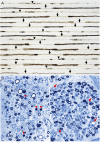Clinical Manifestations and Treatment Responses in Pediatric Neurofascin 155-IgG4 Autoimmune Nodopathy
- PMID: 39823553
- PMCID: PMC11744604
- DOI: 10.1212/NXI.0000000000200368
Clinical Manifestations and Treatment Responses in Pediatric Neurofascin 155-IgG4 Autoimmune Nodopathy
Abstract
Background and objectives: While it is well characterized in adults, little is known about the clinical features of neurofascin 155-IgG4 autoimmune nodopathy (NF155-IgG4 AN) in the pediatric population. In this study, we aimed to describe the clinical features and treatment outcomes in children diagnosed with neurofascin 155-IgG4 autoimmune nodopathy (NF155-IgG4 AN).
Methods: Pediatric and adult patients with NF155-IgG4 AN were identified retrospectively through the Mayo Clinic Neuroimmunology Laboratory database.
Results: Eight pediatric and 20 adult patients with NF155-IgG4 AN were included with a median age at onset of 11 and 43 years, respectively. Pediatric patients (3/8) were often diagnosed initially with Guillain-Barre syndrome compared with adults (2/20) (p = 0.123). Six pediatric patients deteriorated beyond 2 months with rapid progression to disease nadir compared with adults (22 vs 52 weeks, p = 0.04). All had distal predominant weakness with paresthesias. Four patients had tremor, and one had cerebellar ataxia. Sensory ataxia was significantly less common in pediatric patients (4/8) compared with adults (18/20) (p = 0.038). Most pediatric patients (6/7) were IVIG refractory and responded to rituximab. Six patients had favorable outcomes after immunotherapy with improvement ≥1 in the Inflammatory Neuropathy Cause and Treatment disability score.
Discussion: Pediatric patients with NF155-IgG4 AN display an aggressive disease course with rapid progression to disease nadir compared with adults. Sensory ataxia is less common in children, and they often respond to rituximab. It is crucial to consider autoimmune nodopathies in the differential diagnosis of pediatric patients with suspected inflammatory demyelinating polyneuropathy and to test for NF155-IgG4 antibodies because of their diagnostic and therapeutic implications.
Classification of evidence: This study provides Class IV evidence that in pediatric patients with NF155-IgG4 AN who are refractory to IVIG, rituximab treatment provided some benefit.
Conflict of interest statement
P.J.B. Dyck reports research funding from Alnylam and Ionis. M.L. Mauermann has received research funding from IONIS and Alnylam. J. Mills has patents related to detection of monoclonal immunoglobulins by mass spectrometry and has filed patents on antibody biomarkers of neurological autoimmunity. D. Dubey has consulted for UCB, Immunovant, Argenx, Arialys and Astellas pharmaceuticals. All compensation for consulting activities is paid directly to Mayo Clinic. He is a named inventor on filed patent that relates to KLHL11 as marker of autoimmunity and germ cell tumor. He has patents pending for LUZP4-IgG, cavin-4-IgG and SKOR2-IgG as markers of neurological autoimmunity. He has received funding from the DOD (CA210208 and PR220430), David J. Tomassoni ALS Research Grant Program and UCB. All other authors report no relevant disclosures. Go to
Figures


References
MeSH terms
Substances
LinkOut - more resources
Full Text Sources
Research Materials
